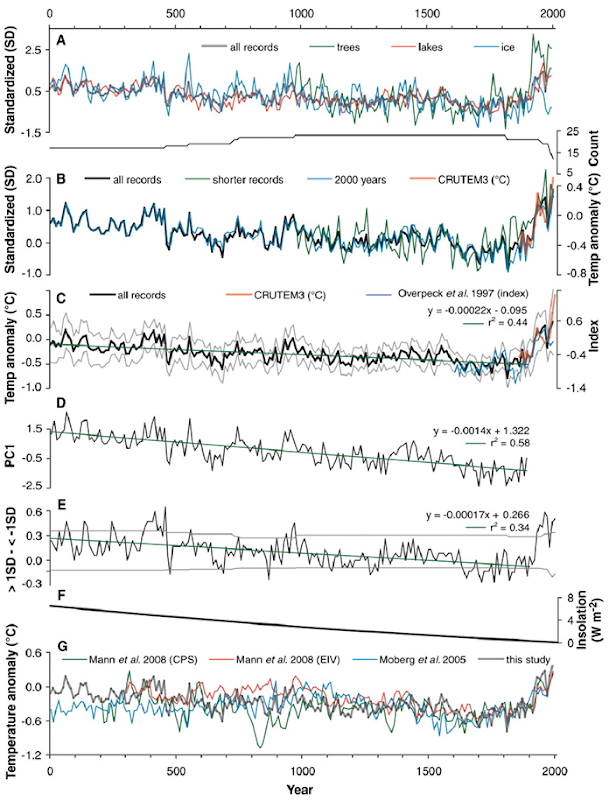Graph of the Day: 2000-Year Reconstruction of Arctic Temperatures
Fig. 3. (A and B) Composite of 23 high-resolution proxy climate records from the Arctic. Values are 10-year means standardized relative to the reference period of 980 to 1800. (A) Records subdivided by source of proxy information: trees, ice, and lakes, with the running count of records. (B) Records subdivided by those that extend 2000 years (n = 17) versus shorter records (n = 6), along with the 10-year-mean Arctic-wide summer temperature through 2000 from the CRUTEM3 data series (14) (red line). (C) Mean of all records transformed to summer temperature anomaly relative to the 1961–1990 reference period, with first-order linear trend for all records through 1900 (green line), the 400-year-long Arctic-wide temperature index of Overpeck et al. (2) (blue curve; 10-year means), and the 10-year-mean Arctic temperature through 2008 (red line). Gray lines encompass ±2 standard errors of the proxy values as evaluated for each 10-year interval. (D) Time series of PC1 based on the 15 records that extend from 1 C.E. to 1900 C.E., showing a strong first-order trend. (E) Difference in the fractional proportion of records that exceed ±1 SD for each 10-year interval. Gray lines are 95th percentile of distributions determined by 10,000 Monte Carlo realizations of shifting the time series randomly in time [as in (15)]. (F) Change in summer (JJA) insolation at 65°N latitude relative to the 20th century (21). (G) Northern Hemisphere average proxy temperature anomalies (10-year means) reconstructed by Mann et al. (26) on the basis of two approaches (CPS, composite plus scale; EIV, error in variables) and by Moberg et al. (27). Our Arctic regional reconstruction is overlaid in gray. Abstract: The temperature history of the first millennium C.E. is sparsely documented, especially in the Arctic. We present a synthesis of decadally resolved proxy temperature records from poleward of 60°N covering the past 2000 years, which indicates that a pervasive cooling in progress 2000 years ago continued through the Middle Ages and into the Little Ice Age. A 2000-year transient climate simulation with the Community Climate System Model shows the same temperature sensitivity to changes in insolation as does our proxy reconstruction, supporting the inference that this long-term trend was caused by the steady orbitally driven reduction in summer insolation. The cooling trend was reversed during the 20th century, with four of the five warmest decades of our 2000-year-long reconstruction occurring between 1950 and 2000.
